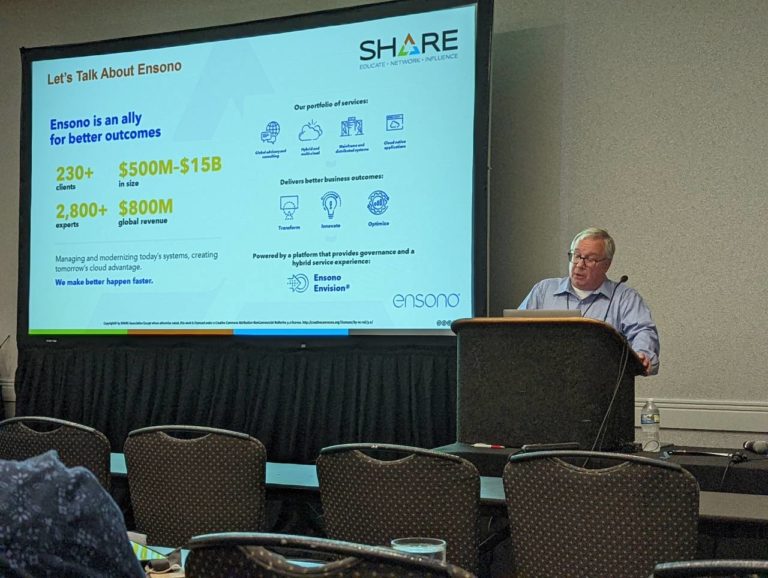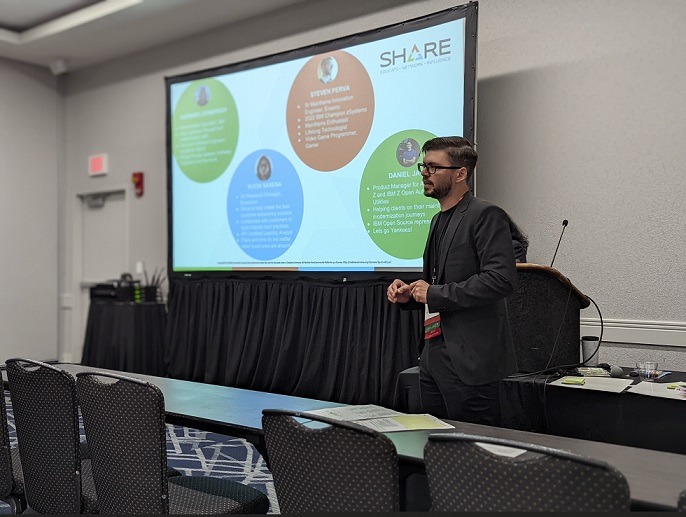SHARE Conference 2022 Highlights

Michael Fontanetta
Director, Mainframe Innovation Engineering

Steven Perva
Senior Mainframe Innovation Engineer
The SHARE conference in Columbus saw over 1200 in-person attendees and critical vendors in mainframe gathered to talk about technology, the future of the mainframe platform, and the new generation of mainframe professionals. Ensono Mainframe experts hosted and participated in sessions on key topics including automation, collaboration and teambuilding, modernization, MSP client success, and platform sustainability.

Takeaways from SHARE 2022
1. Zero Trust
As the demand for system interconnectivity grows, the security of all systems also must rise to protect the data, its users, and the business from unauthorized access, corruption, and theft.
With the average cost of data breaches hitting an all-time high in 2022, organizations are looking to establish improved security postures. Zero trust is an approach to IT security employing a “never trust, always verify” methodology to access requests. Leveraging a zero-trust approach increases environment resilience and decreases data exposure caused by a breach. Authorization and auditability continue to be challenging when data is replicated across the enterprise. The zero-trust approach ensures that data consumers have the right access at the right time and under the right circumstances to the data needed to perform their function while documenting access to critical data.
2. DevOps Pipelines
SHARE offered multiple sessions surrounding the use of DevOps pipelines.
As the mainframe industry begins to see an increasing demand for agility, the steady pace of making software and infrastructure changes can make it difficult for organizations to meet their business goals. DevOps pipelines create self-documenting, automated processes that put the “Continuous” in CI/CD by automating the execution of deployments, tests, vulnerability scans, and even compliance tasks. Coordinating tasks in a hybrid cloud environment can easily be achieved using pipelines. Pipelines enhance the ability to rapidly deploy changes to applications and infrastructure without reducing the functionality or integrity of either.
While the use of pipelines has increased, the demand for securing them has also increased with the introduction of automated policy enforcement, vulnerability scanning of artifacts, and end-to-end accountability.

3. Insights
Enhanced AI capabilities elevate mainframe business processes by as much as 85% improvement.
The new z16 platform brings AI and cyber resiliency to hybrid cloud by using on-chip AI inferencing and quantum-safe technologies. This provides security and business continuity enhancements positioning clients to stay ahead of threats being introduced through quantum processors. With the new z16 AI and cyber capabilities, new insights are available through generated (SMF) system logging. These insights will provide a crypto inventory along with AI business application improvements which can be shared with supported clients. New cyber resiliency capabilities also provide APIs to allow clients to integrate quantum-safe technologies to be integrated into their business applications.
4. Containerization
Containers on the IBM Z platform were a key topic during the Columbus SHARE conference.
The RedHat OpenShift Container Platform (RHOCP) provides agility, flexibility, and security to reduce barriers to innovation as part of the mainframe overall hybrid and multi-cloud strategy. The implementation of the RHOCP on IBM Z functions the same as traditional Linux OpenShift, allowing practices from other platforms to be leveraged increasing speed to market.
System reliance and security provided by the mainframe make this an ideal strategy to adopt in support of the hybrid platform. Containerized workloads allow the co-location of containerized and traditional workloads while providing a scalable non-disruptive solution to accommodate the substantial increase of workload on demand.
5. Open Telemetry
Collecting application and infrastructure telemetry data is key to providing organizational insights into business processes.
The telemetry tools deployed are normally platform-centric and, commonly, clients have acquired and currently use multiple telemetry tools on each platform. The Open Telemetry Project (OTP) provides a solution where telemetry application and infrastructure data can be leveraged to provide a platform agnostic single pane of glass. The ability to have a platform-agnostic telemetry solution provides a significant benefit to the DevOps teams.
Social Share
Don't miss the latest from Ensono
Keep up with Ensono
Innovation never stops, and we support you at every stage. From infrastructure-as-a-service advances to upcoming webinars, explore our news here.
Blog Post | April 16, 2025 | Industry trends
Closing the Cloud Skills Gap with Engineering Talent that Flexes with You
Blog Post | April 8, 2025 | Technology trends
IBM z17: The Age of AI on The Mainframe Has Arrived. Are You Ready to Meet It?
Blog Post | March 19, 2025 | Industry trends